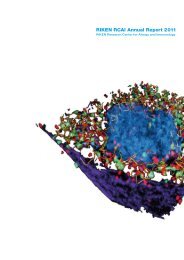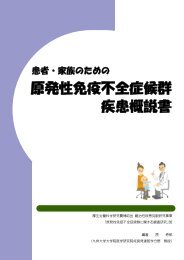Immunity
Immunity
Immunity
- No tags were found...
Create successful ePaper yourself
Turn your PDF publications into a flip-book with our unique Google optimized e-Paper software.
esponse to this program has convinced me of the importance offurther strengthening advanced imaging activities at the Centerand I am pleased that the RCAI Advisory Council has also notedin its report that imaging is an area where RCAI’s basic researchcapabilities and Central Facilities platform provide for a superbenvironment for future world class research.The value of a novel research technique also depends upon its“usability” and simply upon the number of scientists who haveaccess to it. New enhancements of the basic technique, such asmulti-color fluorescent imaging, together with novel fluorescentdyes developed at RIKEN and sophisticated new software toolsdeveloped by the Research Unit for Single Molecular Immunoimagingin cooperation with the Olympus Corporation, will make thetechnology available to a much larger number of non-expert users.We will continue to invest into technology development and ourgoal over the next years is to build up an extensive imaging focusat the Center, providing access to the most advanced techniques insingle-molecule imaging, single-cell imaging, and in vivo imaging.Based on these continuing investments and partnerships with scientistsand instrumentation companies worldwide, I believe thereis a real opportunity for RCAI to become the one of the world’sleading centers for advanced imaging research in immunology.I would also like to mention our increased investment intobioinformatics. Last year we established a new database tool, ReferenceDatabase for Immune Cells (RefDIC) [http://refdic.rcai.riken.jp/welcome.cgi]. RefDIC is a database with a host of “omic” dataon various types of immune cells that has been prepared by theLaboratory for Immunogenomics in cooperation with various userswithin RCAI. While far from complete, RefDIC offers a broad varietyof mRNA and protein profiles for a growing number of immune celltypes and this collection will continuously expand over the next fewyears. Over time, and as more data and also different types of dataare added, RefDIC will become a powerful informatics platform forimmunologists worldwide.Over the past year, we have also been strengthening our bioinformaticscapabilities through various domestic and internationalpartnerships. In this context, we mention here especially a partnershipwith the leading bioinformatics center in India through whichRCAI scientists will gain access to advanced bioinformatics services.Various other projects at the Center also fall within the areaof bioinformatics. I have already mentioned a project to developan Asia-wide database of human immunodeficiency patients thateventually should be linked to both clinical and genetic information.Such a database will be of immense value to translational researchin many areas of immunology. And again, these new investmentsare backed by the recommendations of RCAI’s Advisory Council.RCAI’s New Research Coordination Office (RCO)Another innovation at RCAI that has received high marksfrom the Advisory Council is the Center’s Research CoordinationOffice (RCO). The primary role of the RCO is to provide professionalsupport to scientists in all aspects of grant acquisition and management.In addition, the RCO is responsible for a broad variety ofactivities, including evaluation, dedicated support for postdoctoralfellows and young scientists, planning of events and educationactivities, and even outreach and public relations.One important motivation to set up the RCO relates toresearch funding. RIKEN’s budget is set to shrink rather thanincrease. This annual reduction in base funding allocations is notparticular to RIKEN or RCAI. Rather, it is motivated by thefact that most research organizations, including RIKEN, also fallunder legislation which requests a minimum annual decrease inbase funding of at least 1% per year.In order to increase research activities, we now need to competefor funding from both internal sources (such as RIKEN) andexternal grant programs. When we started RCAI, the total amountof external funding acquired by all research groups, which, during2001-2003 were still primarily located at their respective universities,was well over JPY 800 million (US$ 7 million). After moving tothe Center, external funding decreased somewhat to less than US$5 million per year. Now, with base funding of the institute decliningfor the second year in a row, there is little choice but to raise ourshare of competitive funding again. But, while the large, experiencedresearch groups have considerable experience in fundingacquisition, the same is not true for most of the smaller groups. Theactivities of the RCO are especially important in supporting younginvestigators as they compete for outside funding.Hardly a year in its existence, the output of the RCO is alreadyimpressive. In the case of grant applications, over the past yearthe RCO has supported 19 applications for various types of grantsunder the highly competitive RIKEN President’s Fund. In 2006, 4applications from RCAI among a total of 226 applications fromall of RIKEN have been funded for a total of over JPY 220 million(US$ 2 million). Since the average acceptance rate for all RIKENapplications was 12.0%, the RCAI acceptance rate (21.1%) wassignificantly higher. The RCO has also supported numerous applicationsto external grant programs and scientific prizes andthe success rate has been well above average. In summary, therelatively small investment that has gone into setting up the RCOhas already paid off handsomely. And, for me as the director ofRCAI, the RCO is providing important support for a number ofcritical tasks.A second rationale for setting-up RCO relates to the way researchcenters are administrated within RIKEN. At the YokohamaInstitute, a generic administrative service provides highly componentsupport to all four research centers located on the campus.RCAI has profited enormously from this core support. However,the focus within the RIKEN administration is on highly standardizedtasks that are not different for any of the centers. Therefore itseemed necessary to create a small, versatile research managementorganization that caters more specifically to the needs ofRCAI investigators and RCAI laboratories. RCO fulfills a numberof crucial functions at the Center. To start with, RCO supportsscientists with the acquisition of external funding. In Japan, this isan innovation. While a standard practice in the US and increasinglyalso in Europe, support staff for grant acquisition or grant managementsimply does not exist yet in Japan. I add here that RCO alsoserves as an interface with the RIKEN research promotion division.Secondly, RCO fulfills a variety of internal coordination tasks, fromorganizing regular seminars for internal postdoctoral fellows to theplanning of our new RCAI International Summer Program in Immunology.Finally, RCO assists the director and RCAI managementteam in formulating a long-term research strategy for the Center.This is a most crucial task and, given the new funding environmentfor the Center, certainly not a trivial one.While research organizations in Japan typically look at researchmanagement as yet another administrative function no differentfrom accounting or facility management, at RCAI we have set thestandards as high as the standards we set for hiring scientists.We have spent considerable time in selecting the best staff forthe institute — PhD scientists with an experience in research andeven a track record in immunological research. I am especiallyglad that Dr. Toshi Takemori (working on Immunological memory)has agreed to join the institute as both a research scientist and an





